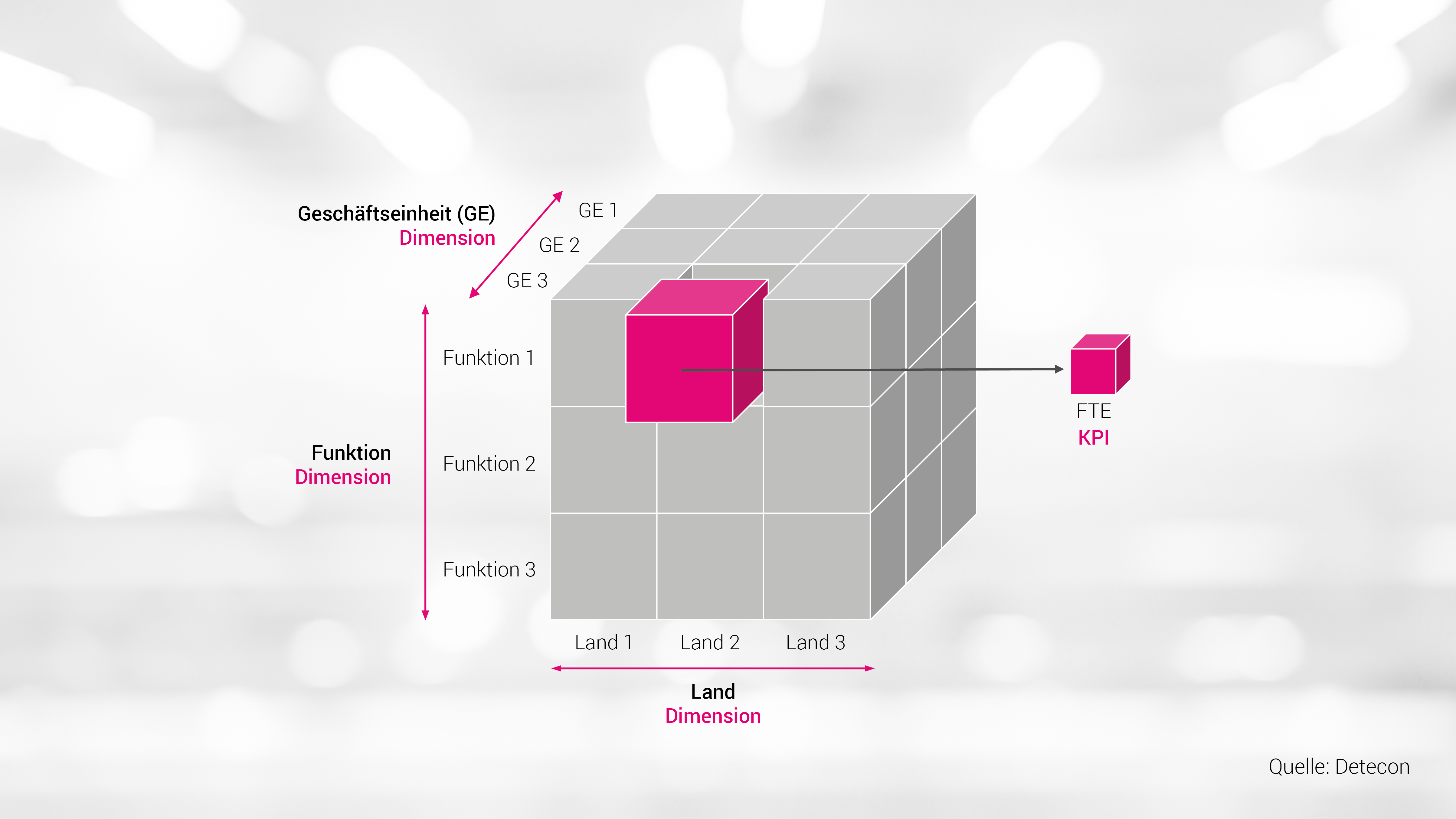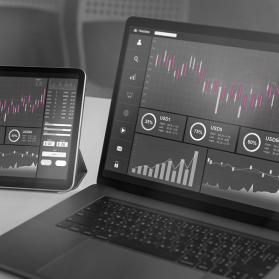The introduction of a data cube as an element of the workforce management at T-Systems has led to a massive reduction in the complexity of the processes while at the same time enabling the team to respond quickly to various corporate changes. Stephan König, head of the department Workforce Controlling, spoke to us about the opportunities and challenges that arose during the introduction of the tool.
Detecon: Stephan, you are the head of Workforce Controlling at T-Systems. What do your duties include?
Stephan König: At the heart of our work are the planning and forecasting of the workforce KPIs during the year, i.e., both the FTE and the associated costs of the in-house and external workforce. But of course, we also generate regular projections that give us an idea on where the workforce stands, the analysis of the as-is figures, and, based on the analysis of these figures, forecasts of how the key KPIs will develop. Add to this the project support we provide for upcoming staff reassignments and for reorganization and restructuring projects for which workforce issues are always a key point. This is especially true in a business that is as personnel intensive as T-Systems.
Last year, we jointly launched a project that deals with the design, implementation, and subsequent use of a data cube. What would you say is the best way to describe the data cube? What was the primary motivation behind its introduction?
I will start with the second part of the question. We were facing three major challenges at T-Systems. The first was that we have a very complex planning and forecasting process. This complexity results from the structure of the company: its many and highly varied business divisions and the differences in the dynamics among them. The global positioning of our eleven portfolio units had led to a high degree of planning complexity, and the only management instrument we had to assist us was Excel. The second challenge was to be able to respond quickly and very agilely to changes in the planning structure and to new strategic stimuli – and to be able to access quickly both target and as-is data, structured flexibly, for ad-hoc analyses. And third, our experience over the years has shown us that investments in relatively rigid IT tools are not worth the cost because they do not provide the speed of adaptation that we need in our business.
We viewed the data cube as an approach that would enable us to master all three challenges more or less at the same time. Its main features are, first of all, that it offers the opportunity to hold data for reports and analyses in a single tool and, second, that the team itself is able to make flexible, highly dynamic adaptations and to evolve the tool as necessary. We solved the problem of building an extraordinarily complex IT tool with a single, integrated tool based on Excel.
What specific tasks does the data cube support? What is the actual added value for your work in workforce management?
Specifically, thanks to the data cube, we are now able to create our planning processes – both the iPF and the forecasts – using a single planning template that serves as the planning for the entire company. Where it used to take us perhaps five or six days to consolidate a plan, we now distribute the work among several people within the framework of this process. The templates can be compiled within one working day so a much faster response to any need to change or adjust the planning is possible. And, for the first time, we have found a way to speak the same language as the finance department when naming and describing the KPIs of the planning units. We developed the project in collaboration with our colleagues from finance from the very beginning; this brought us much closer together, and we were even able to agree on common terminology in the various definitions required for the data cube. This simplifies the work greatly because data can now be transferred automatically between the two departments.
But we can today also respond much more quickly when preparing decentralized analyses – such as those for specific business partners or organizational units – because we have collected in one place all the data, all the viewpoints, all the dimensions that we usually work with and can combine and compile them as we wish.

You have just mentioned the decentralized viewpoint. Do you mean the individual PU comptrollers or administrative comptrollers in consultation with the business partners in the segment?
That’s right. The data cube remains an in-house tool for workforce management itself, but it is actually worth its weight in gold. Today is our last day together as T-Systems in its previous form. The carve-out goes into effect tomorrow when significant parts of the company will move to Telekom Deutschland. A maddeningly complex project, accompanied by spin-offs in units and countries where separate limited liability companies are being created and where absolutely all FTEs had to be redistributed. Classic IT tools would not have been able to map this completely new reporting structure without involving IT experts in the programming. But it was achievable using the Excel-based cube. We were able to work better and adapt very quickly and dynamically to this completely new situation. Having a tool that empowers employees who are not experts in programming by giving them the skills for realizing such a project on their own is a powerful asset.
What do you consider to have been the major factors assuring the successful introduction of the data cube? And why was it important to consider other perspectives or even to have external support?
I think our performance of a fundamental problem analysis was truly helpful. So we didn’t just go out and buy a tool of some kind or have one developed; we first asked ourselves what concerns and needs we had that needed to be resolved. During the second phase, we looked for the right solution to master these challenges. And then, in what was certainly a very fortunate coincidence, two things came together. First, we had the full backing of management as we took on this issue and we were assured the required budget and external support for it. And second, we came across this solution, which I think is very creative, that provides access to Power Pivot in Excel as a solution option. In the next phase, external support was a highly critical success factor for us as it allowed us to focus our complete concentration on a subject that, while important, was not urgent because of the time period allowed for its implementation and to develop it to a degree of maturity that quickly generated an impact.
When you do not have external support, you run the risk of being distracted repeatedly by pressing ad hoc issues. But: it was also important that the external support that Detecon provided to us worked very closely with the technical experts on the team. We had a truly integrated approach that kept us in close alignment with our real needs during every phase of the project while simultaneously giving us the resources and skills to draft a concept and realize such a project.
You have spoken a lot about the advantages and added value of the data cube. What was the biggest challenge during implementation?
The first step was to gain the acceptance of everyone who had not been involved in the development of the data cube from the beginning. We invested a lot of effort in bringing our colleagues on board and explaining the added value, the benefits, and how to use the tool. This was for some really an eye-opener, and it was highly satisfying that we were able to convince everyone of the value of the tool in a relatively short time once they had worked with it.
What skills must employees have so that they can work with the data cube?
I would divide them into two groups. One comprises the users. With the exception of two or three little tricks, these people do not need to know much more than how to work with Excel. That is what makes this tool so charming. Workforce managers are competent in the use of Excel, of course, because they work with the program every day, so they have a relatively low hurdle to clear when learning to work with the cube.
The second group includes the people who are working on the further development of this tool. That is another charming feature of the data cube – it is not a finished product. It is an ongoing development: first, to reflect changes that are constantly occurring and, second, to encompass even more areas where we can benefit. The people in this group have to understand the complexity of the processes and interdependencies involved in this tool, namely, the merger, superimposition, translation, and calculation of data from multiple sources in a multitude of dimensions. The real art is in understanding the inherent complexity of the database and the database structure behind it. But even for this, you don't need programmers, just experts who are familiar with the in-depth structure of the cube.
DATA CUBE
- A data cube is a multidimensional database in which large amounts of data can be flexibly evaluated in various forms. Multidimensionality enables the user to analyze key figures while simultaneously viewing several dimensions. The dimensions can be combined in any combination, allowing a wide variety of questions to be answered, reports and evaluations to be created with different levels of significance, and important operational key figures to be extracted quickly and in line with requirements.
- etecon supports its clients in the areas of data analytics as well as process standardization and automation, among other things with the aid of database tools.
When you look back today, what are your top three lessons that you learned from the introduction and use of the data cube?
The absolutely most important thing from my point of view is the recognition of the value of such an adaptable tool. A fundamental insight is realizing how significant the data cube is in a world in which organizations, structures, and strategies must be constantly adapted to keep pace with the highly dynamic workings of the market. In the past, we had to be satisfied with an Excel tool, but now we have much more flexibility in responding quickly to changes. This is tremendous added value, not only in comparison with Excel alone, but with regard to most specialized IT tools as well.
The second lesson learned relates to the complexity that arises from bringing various data and reports together so that they can really be linked with one another. Data stocks, deduction data, KPI definitions have to be lined up in succession, and that cost us a lot of time. We actually did a good job here, but I think we underestimated the scope of the task beforehand. I was really impressed to see how much complexity must be processed in the cube so that the complexity in day-to-day work can be reduced.
The third lesson learned is what I said in the beginning: even when you have a tool that can basically develop itself further, you still have to free up capacities so that you can continue to work ceaselessly on advanced development. Otherwise, you will quickly be overwhelmed again by the daily business.
Let’s take a quick look into the future. How would you like to see you and your team advance the development of workforce management? What developments do you think we will see in the field of workforce management over the next five to ten years?
Interestingly, T-Systems now has another project in progress called HR Analytics that is also supported by Detecon. The next step is to take the linking of data and support one step further by collecting and analyzing support activities, data, and KPIs in the HR department as a whole as well as in the HR-related environment. But of course there are a lot more data beyond these areas that are relevant for HR: ongoing learning, hiring details, recruiting processes, capacity management, bench management, etc. – highly diversified topics that are currently being dealt with in and around the HR unit in the most disparate organizational units. We are now trying to bring these topics together as well with the aim of creating assessment and possibly BI opportunities in the next step. It will be exciting to discover whether we can find a solution offering all the advantages and adaptability of the cube, but able to digest even more complexity.
I am extraordinarily keen to move even further ahead in this respect and pool even more data to obtain ever more sophisticated analyses, comparisons, and planning indications. Different organizational units must now work together, which means that the work will no longer take place on a team that develops the tool; there are a lot more interfaces. Thanks to having the data cube, we are well prepared to take on this task and have done our homework. On the other hand, while we, the workforce management team, are using the data cube today as a very valuable tool, it still does not serve as an instrument that goes beyond the organization and with which the HR business partners and level managers also work directly. That means that user interfaces fine-tuned for high usability and easy handling that I can use to simplify the completion of planning templates, etc., are still lacking to some degree as a connection point. So we need a tool that managers or HR business partners can use to plan or create forecasts. Everyone personally enters his or her own data and receives feedback on the role of the data within a strategic planning concept.
And that brings us to the second part of the question. I think most of what we do in this area of management today will certainly be handled by intelligent systems in the future so that the actual planning process can be related much more closely to the business because the feedback is much faster.
The managers in charge of the business should be able to operate various levers themselves in the future and receive immediate feedback on what happens if they change the positions of these levers. Workforce managers will provide a different service in the future. They will sit down together with the business side much more often and consider how to deal with the challenges facing them all rather than spend time integrating figures and creating Excel sources. In other words, their work will be oriented more in the direction of counseling and content. As I see it, this is the direction in which we must move.
Stephan, thank you very much for the interview and the interesting insights.
I’m the one who must thank you! Without the professional, committed, and always pleasant support from the Detecon team, the project would not have been possible in this form. Thank you!







